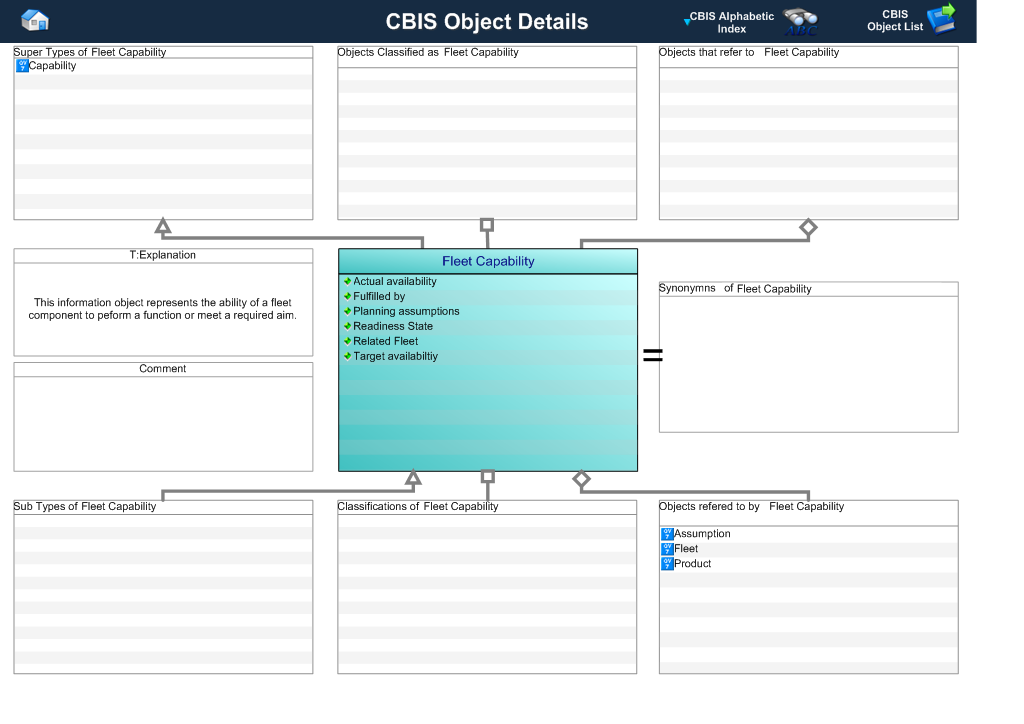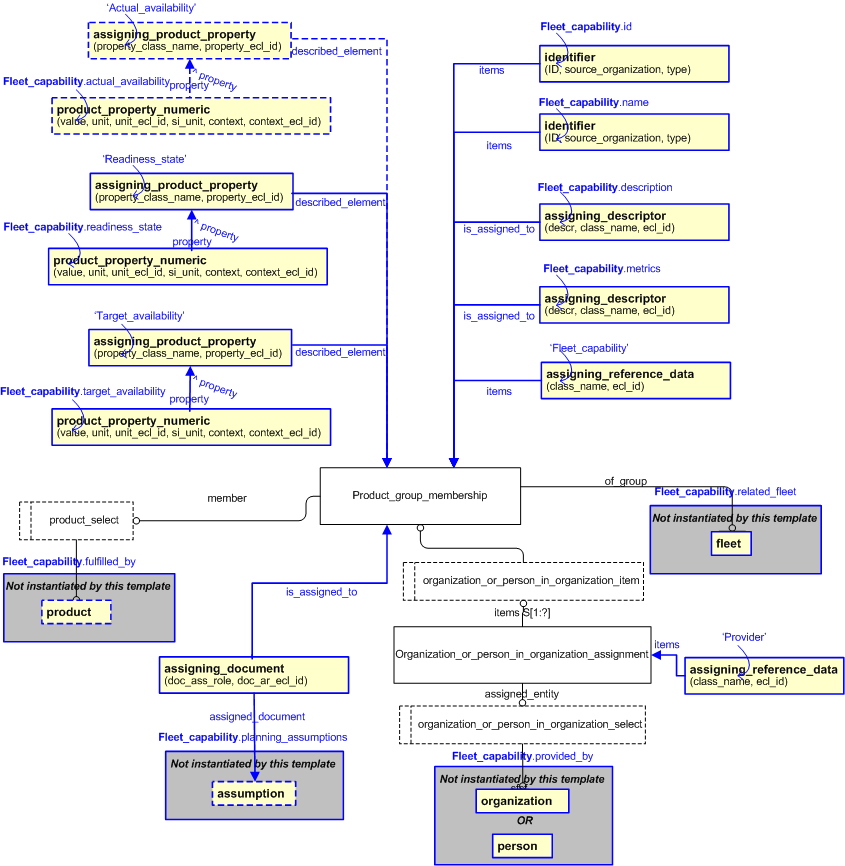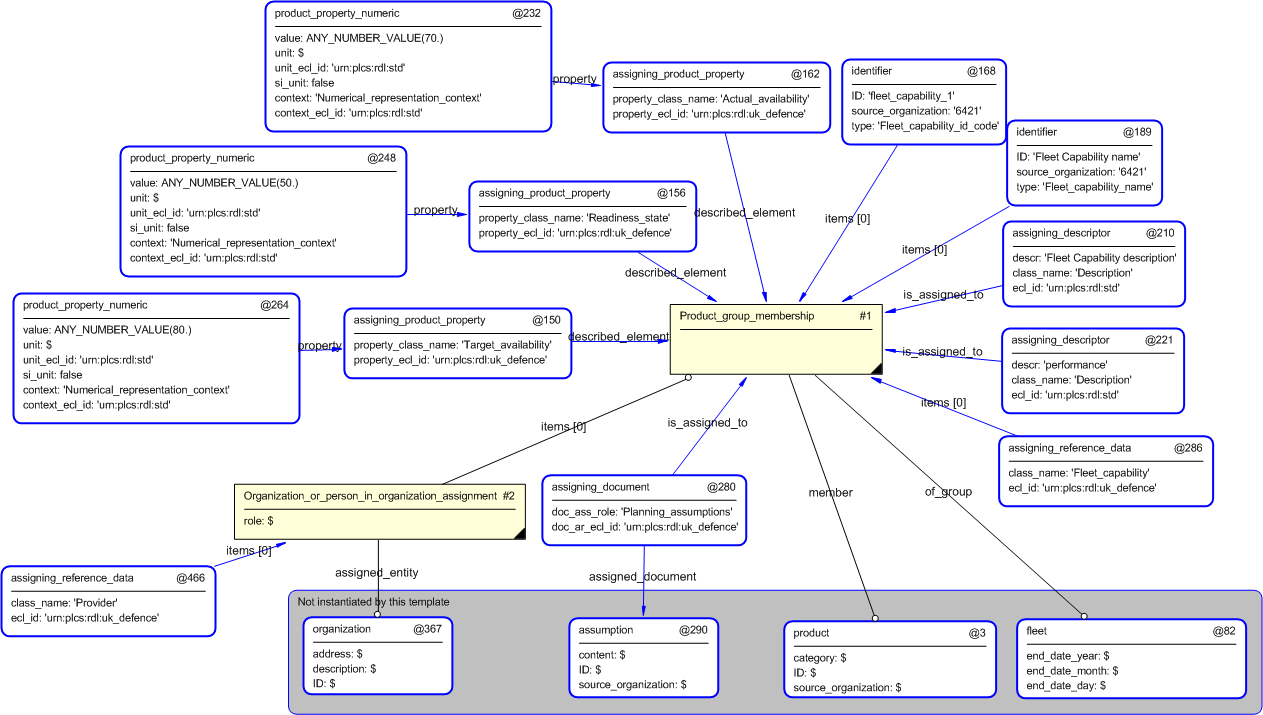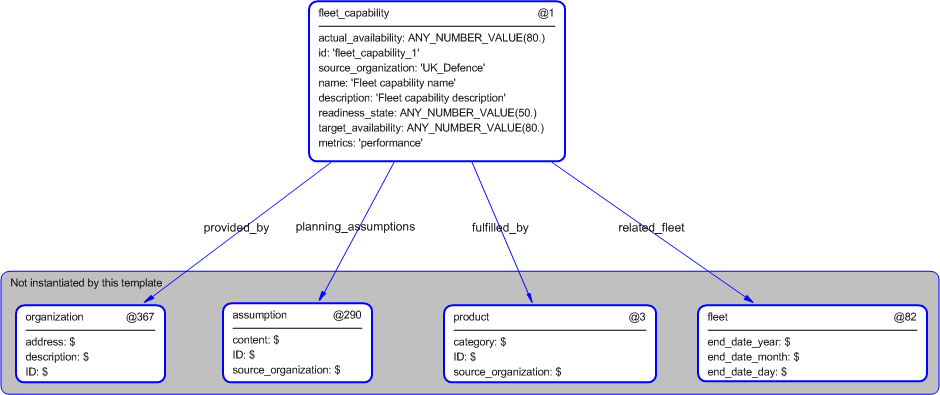Template:— fleet_capability (flt_cap)
Context:— UK_Defence |
Date: 2010/03/15 14:22:42
Revision: 1.5
|
This section specifies the template fleet_capability.
NOTE
The template has been defined in the context of
UK_Defence.
Refer to the business context for details of related templates.
NOTE
An explanation of a template and the associated instantiation path is
provided in the
Template overview
section.
This template describes how to represent the concept of a fleet capability in terms of PLCS model elements (templates, entities,
and reference data).
A fleet capability is the ability of a fleet component to perform a function or meet a required aim.
This information object represents the ability of a fleet component to perform a function or meet a required aim.
Figure 1 — A MOOD Business Architect representation of the Business Object: Fleet Capability
The attributes of the Fleet Capability object are tabled below.
|
Attribute name
|
Attribute description
|
Attribute type
|
Optionality
|
| Actual availability |
This is the ratio of the time the product is is available for operational use.
This may be presented as a % e.g. 90% availability.
|
intrinsic |
Optional |
| Fulfilled by |
This is a reference to the product or asset that fulfills the fleet capability requirement. |
Relationship to Product |
Optional |
| ID |
This is the identifier of the fleet capability. |
intrinsic |
Mandatory |
| Identifier.id |
This is the value of the id attribute of the Identifier applied to the fleet capability. |
intrinsic |
Mandatory |
| Identifier.type |
This attribute is the type associated with the id of the Identifier given to the fleet capability. |
fleet_capability_id_code |
Mandatory |
| Identifier.source_organization |
This attribute is the value representing the source organization that provides the id of the Identifier given to the fleet
capability. This value is assumed to be a type of Organization_identification_code.
|
Organization_identification_code |
Mandatory |
| Name |
This is the name of the fleet capability. |
intrinsic |
Mandatory |
| Planning assumptions |
This is a reference to the assumptions related to the planning of the fleet capability. |
Relationship to Assumption |
Optional (0:?) |
| Readiness State |
This is the time it takes the Platform System or Equipment to be prepared for a mission.
The time might include,
- refuelling
- checks that are carried out between missions or sorties
|
intrinsic |
Mandatory |
| Related fleet |
This is a reference to the fleet for which the capability is required. |
Relationship to Fleet |
Mandatory |
| Target availability |
This is the ratio of the time the product is expected to be available for operational use.
This may be presented as a % e.g. 90% availability.
|
intrinsic |
Mandatory |
Table 1 — Fleet Capability attribute details
The EXPRESS-G diagram in
Figure
2
shows the templates and EXPRESS entities that are required
to represent the template
"fleet_capability".
The text highlighted in blue shows the template parameters.
Figure 2 — An EXPRESS-G representation of the Information model for fleet_capability
The graphic for the template to be used in other EXPRESS-G diagrams
is shown in Figure
3
below.
Figure 3 — The graphical representation of the fleet_capability template
The following input parameters are defined for this template:
This is the ratio of the time the product is is available for operational use.
This is a reference to the product that fulfills the fleet capability requirement.
This is the identifier of the fleet capability.
The organization that created the associated identifier. Additionally
a Person or Information System could be defined when either of these are the source; see Identifier template characterizations.
This is the name of the fleet capability.
This is the description of the fleet capability.
This is a reference to the assumptions related to the planning of the fleet capability.
This is the time it takes the Platform System or Equipment to be prepared for a mission.
This is a reference to the fleet for which the capability is required.
This is the ratio of the time the product is expected to be available for operational use.
This is a set of parameters that define the capability.
This is a reference to the person or organization providing the capability.
The following reference parameters are defined for this template:
%^target = $fleet_capability.fleet_cap%
The instantiation path shown below specifies the entities that are to be
instantiated by the template.
A description of templates and the syntax for the instantiation path is
provided in the
Templates Help/Information section.
-- [optional fulfilled_by] -- related_fleet Product_group_membershipProduct_group_membership.member ->
@fulfilled_byProduct_group_membership.of_group ->
@related_fleet%^fleet_cap =
Product_group_membership%
-- id /
identifier(
ID=@id,
source_organization=@source_organization,
type='fleet_capability_id_code',
items=^fleet_cap)/
-- name /
identifier(
ID=@name,
source_organization=@source_organization,
type='fleet_capability_name',
items=^fleet_cap)/
-- description /
assigning_descriptor(
descr=@description,
class_name='Description',
ecl_id='urn:plcs:rdl:uk_defence',
is_assigned_to=^fleet_cap)/
-- metrics /
assigning_descriptor(
descr=@metrics,
class_name='Metrics',
ecl_id='urn:plcs:rdl:uk_defence',
is_assigned_to=^fleet_cap)/
/
assigning_reference_data(
items=^fleet_cap,
class_name='Fleet_capability',
ecl_id='urn:plcs:rdl:uk_defence')/
-- relationship to provided_by Organization_or_person_in_organization_assignmentOrganization_or_person_in_organization_assignment.role = '/IGNORE'
Organization_or_person_in_organization_assignment.items ->
^fleet_cap
Organization_or_person_in_organization_assignment.assigned_entity ->
@provided_by%^provided_by =
Organization_or_person_in_organization_assignment%
/
assigning_reference_data(
items=^provided_by,
class_name='Provider',
ecl_id='urn:plcs:rdl:uk_defence')/
-- actual_availability /
assigning_product_property(
property_class_name='Actual_availability',
property_ecl_id='urn:plcs:rdl:uk_defence',
described_element=^fleet_cap)/
%^property_actual = $assigning_product_property.property%
/
product_property_numeric(
value=@actual_availability,
unit='',
unit_ecl_id='urn:plcs:rdl:std',
si_unit='false',
context='Numerical_representation_context',
context_ecl_id='urn:plcs:rdl:std',
property=^property_actual)/
/
assigning_document(
doc_ass_role='Planning_assumptions',
doc_ar_ecl_id='urn:plcs:rdl:uk_defence',
assigned_document=@planning_assumptions,
is_assigned_to=^fleet_cap)/
-- readiness_state /
assigning_product_property(
property_class_name='Readiness_state',
property_ecl_id='urn:plcs:rdl:uk_defence',
described_element=^fleet_cap)/
%^property_readiness = $assigning_product_property.property%
/
product_property_numeric(
value=@readiness_state,
unit='',
unit_ecl_id='urn:plcs:rdl:std',
si_unit='false',
context='Numerical_representation_context',
context_ecl_id='urn:plcs:rdl:std',
property=^property_readiness)/
-- target availability /
assigning_product_property(
property_class_name='Target_availability',
property_ecl_id='urn:plcs:rdl:uk_defence',
described_element=^fleet_cap)/
%^property_target = $assigning_product_property.property%
/
product_property_numeric(
value=@target_availability,
unit='',
unit_ecl_id='urn:plcs:rdl:std',
si_unit='false',
context='Numerical_representation_context',
context_ecl_id='urn:plcs:rdl:std',
property=^property_target)/
The following entities are instantiated with attributes as specified:
The instance diagram in Figure
4
shows an example of the EXPRESS entities and templates that are instantiated by the template:
/fleet_capability(ID='fleet_capability_1', source_organization='6421', name='Fleet Capability name', description='Fleet Capability description', metrics='performance', provided_by='@367', actual_availability='70', fulfilled_by='@3', planning_assumptions='@290', readiness_state='50', related_fleet='@82', target_availability='80')/
(an illustration of the consolidated fleet_capability template is shown in
Figure
5 below.)
Figure 4 — Entities instantiated by fleet_capability template
The instance diagram in
Figure
5
shows the graphic symbol for the template that is to be
used in other instance diagrams. The example template is:
/fleet_capability(ID='fleet_capability_1', source_organization='6421', name='Fleet Capability name', description='Fleet Capability description', metrics='performance', provided_by='@367', actual_availability='70', fulfilled_by='@3', planning_assumptions='@290', readiness_state='50', related_fleet='@82', target_availability='80')/
Figure 5 — Instantiation of fleet_capability template
Characterizations
No common characterizations of the template
fleet_capability
have been identified. However, the ISO 10303-239 EXPRESS model
may enable other assignments to the entities instantiated by the template.




